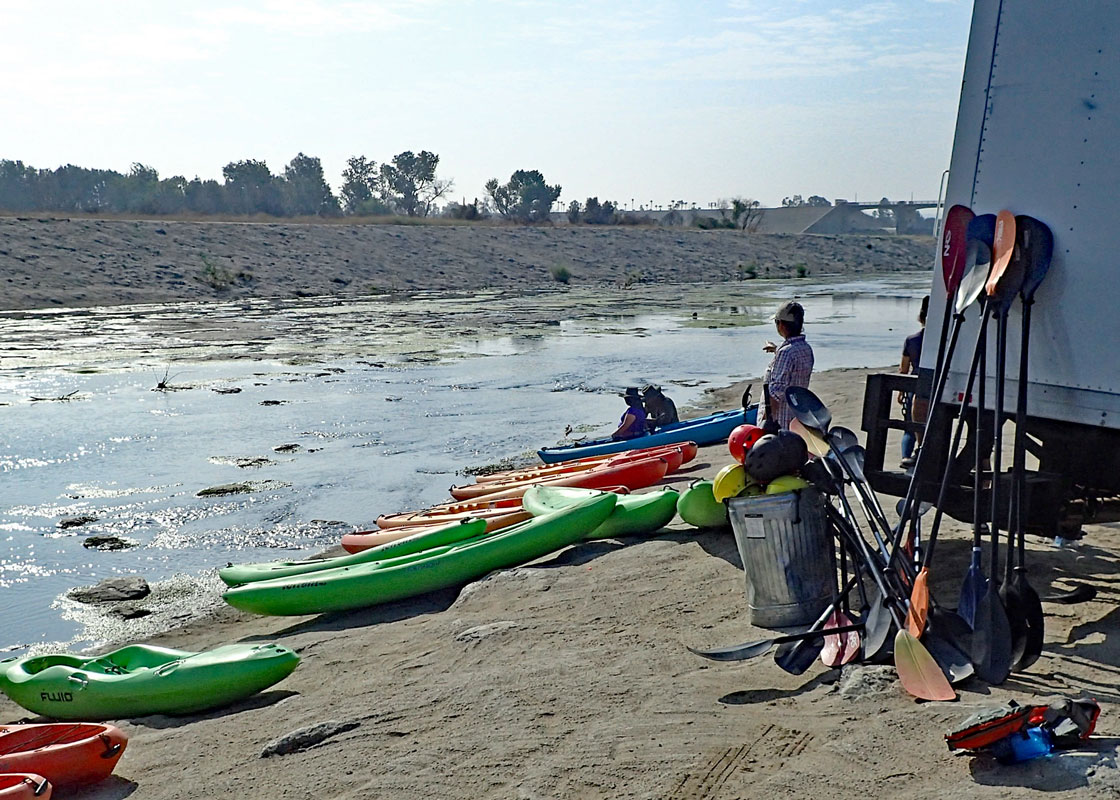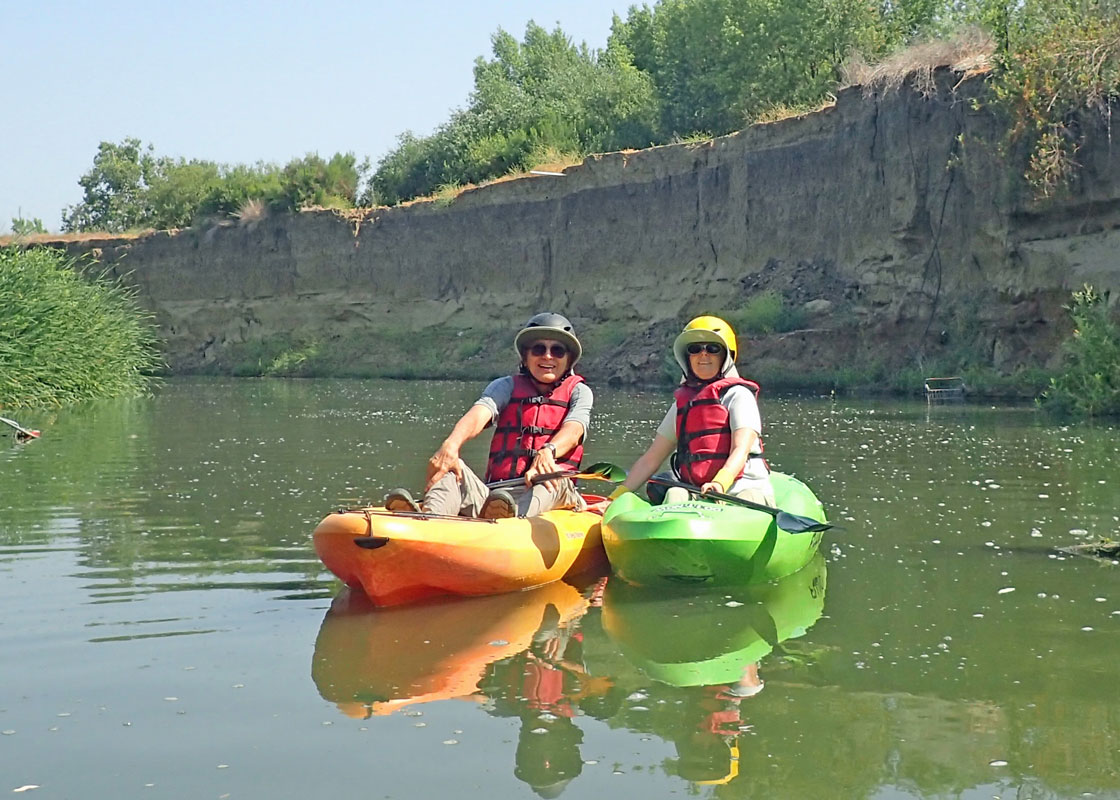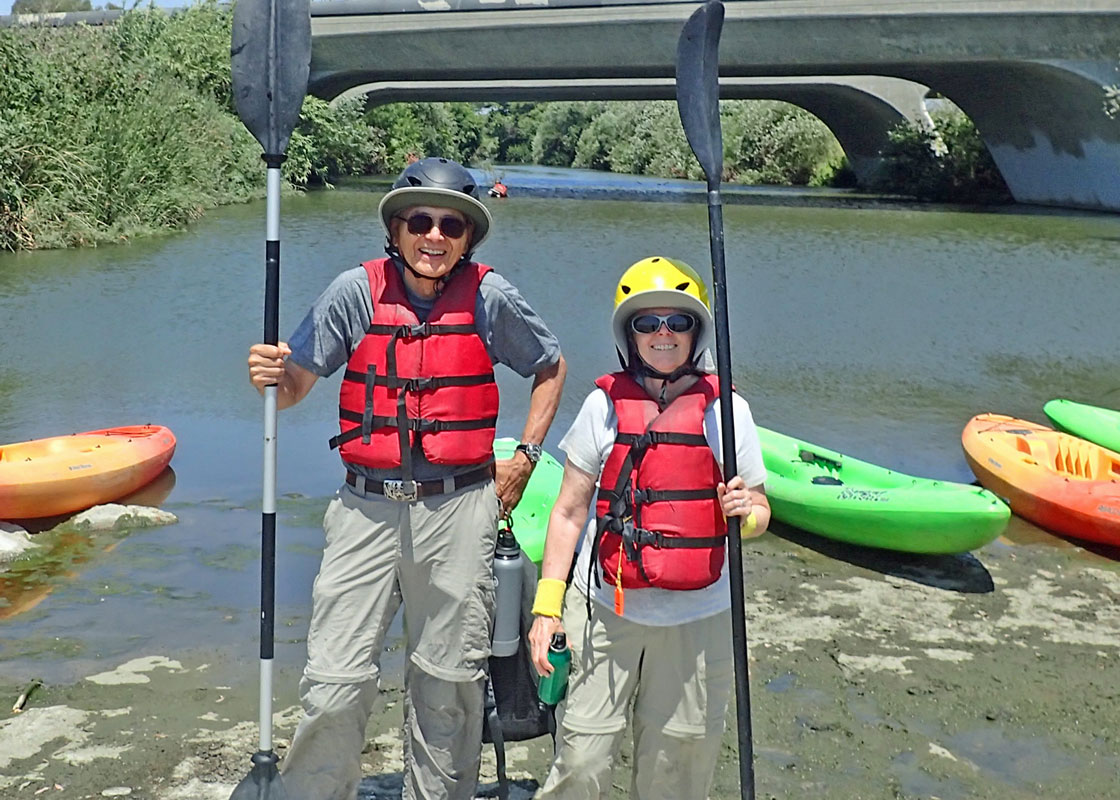
Floating on the Los Angeles River
In the middle of the city, a green refuge
July 7, 2021
My husband Hank and I recently discovered that between Memorial Day and
Labor Day it is permissible to kayak on the Los Angeles River. We signed up
for a tour with L.A. River Expeditions to ride the water near the Sepulveda
Basin, traveling from our house near the Ventura County border to the wilds
of the eastern San Fernando Valley. We parked on Woodley Avenue near Burbank
Boulevard and walked across the street to find the official white van.
Guides pulled out kayaks and lined them up along the water. I immediately
pegged the head guide, Gary, as a river rat. Young, tan, his head covered in
a basket hat, long-sleeved white knit shirt and khaki shorts, he looked like
every guide I'd seen on a raft trip we took down the Colorado River some
years earlier.
One of the kayaks was short and I decided that one was for me. After a few
guidelines on kayaking for those who were new to the sport (both hands hold
the paddle with the long edge on top and move your elbows in a circular
pattern), we found partners and carried our kayaks in to the water,
threading our paths over slippery algae-camouflaged shallow rocks, past
snowy egrets and other water birds.

(Photo: Henry Suzukawa)
My kayak was surprisingly heavy. Hank and I carried it out away from the
concrete and set it in shallow water and came back for his. His long kayak
was considerably lighter, which puzzled me.
Once we pulled the kayaks out in deeper water and sat down in them,
paddling was easy, although my short kayak had a tendency to oversteer.
Sights and sounds of the city were nearby. We soon crossed under Burbank
Boulevard, four lanes of cars each way rattling their engines over the two
bridges. Private jets roared out of Van Nuys Airport.
Yet we were transported to a different world, surrounded by walls of green
trees and bushes, floating on green liquid. I was shocked to see occasional
plastic bags and other debris ten feet up in the tree limbs. I questioned
Gary how trash could have gotten there.
"Flooding," he said. "You'd be surprised how much water comes down the
river when it rains." We hadn't had much rain in the past two years. The
trash apparently had been deposited three years ago. We also paddled around
shipwrecked hulks of shopping carts, their wheels jutting up, ghosts of
capitalism thrown overboard. Farther on, we heard the whine of model
airplanes and drones hidden behind the trees on the right bank from the
Apollo 11 Model Aircraft Field.
Coming closer, I got a chance to read the back of Gary's shirt. "Reduce
Consumption As Much As Possible" in thick black letters. He laughed and
showed the group his back with the same logo tattooed across it. I thought
to myself, Wouldn't it have been easier to get, "Reduce, Reuse, Recycle"?
But that isn't the mark of a true believer.
While we paddled, Gary told us how the river came to be preserved. The
founder of L.A. River Expeditions, George Wolfe, navigated down fifty-one
miles to the ocean. He got permission to film a documentary on the river. At
that time, paddling was not allowed, but filming was. When their group was
stopped by police (helicopters flying overhead, bull horns blaring, "Get out
of the water!"), they showed their filming permit and were allowed to
continue. This film helped establish what was considered a flood control
channel as a navigable river, allowing the federal Clean Water Act to
protect the river and its watershed.

(Photo: Gary Golding)
Around a bend, we came to an area known as the "Little Grand Canyon." A
great packed earth wall greeted us to the right, with small holes
pockmarking the top. All the city sights and sounds disappeared. We were
surrounded by swallows that mesmerized us while they dipped and dived,
catching insects on the wing, their chirping the only song over the liquid
green of the river.
Gary dunked the length of his paddle to show us the depth of the river
here. The entire propeller disappeared. He guessed the depth was much
greater, about ten feet.
All along our float, Gary had been crossing from bank to bank, collecting
small parts of plants. He stopped and had us gather around, our paddles
interlocked, holding us together in the shadows. He pulled out a cattail,
showing us how native Americans had used all parts of it: Seeds and heads
for food, stalks for mats and baskets, roots for medicine. Next, castor bean
whose oil relieves constipation, willow bark as aspirin, and hemlock
intimately known by Socrates. He spoke of stinging nettles, cooked, were a
good source of vitamins. Datura, also known as jimson weed, bloomed on the
hill in huge white flowers. We even saw a wild orange pumpkin skimming the
water.
Heading back, my arms were tired and I found it more difficult to keep the
kayak from turning in circles. I found out later my kayak was better suited
for white water. It was heavy because the bottom was reinforced to guard
against rocks. Oh, well, I'd know better next time. Flat water, long kayak.
We came across single kayaker. Gary introduced us to George Wolfe, out for
a paddle. We all thanked him for his work in helping to save the river that
let us have this green experience in the middle of our dry summer.
At the end of our two-and-a-half tour, we pulled into the landing area and
gingerly climbed out of our boats. Hank and I were both tired, but happy
we'd had a chance to see such a different part of the city we live in. I
even thought maybe we ought to take the tour of the Glendale Narrows, part
of the river also known as Elysian Fields, where I could work on my
white-water skills with that stubby little kayak.

(Photo: Gary Golding)